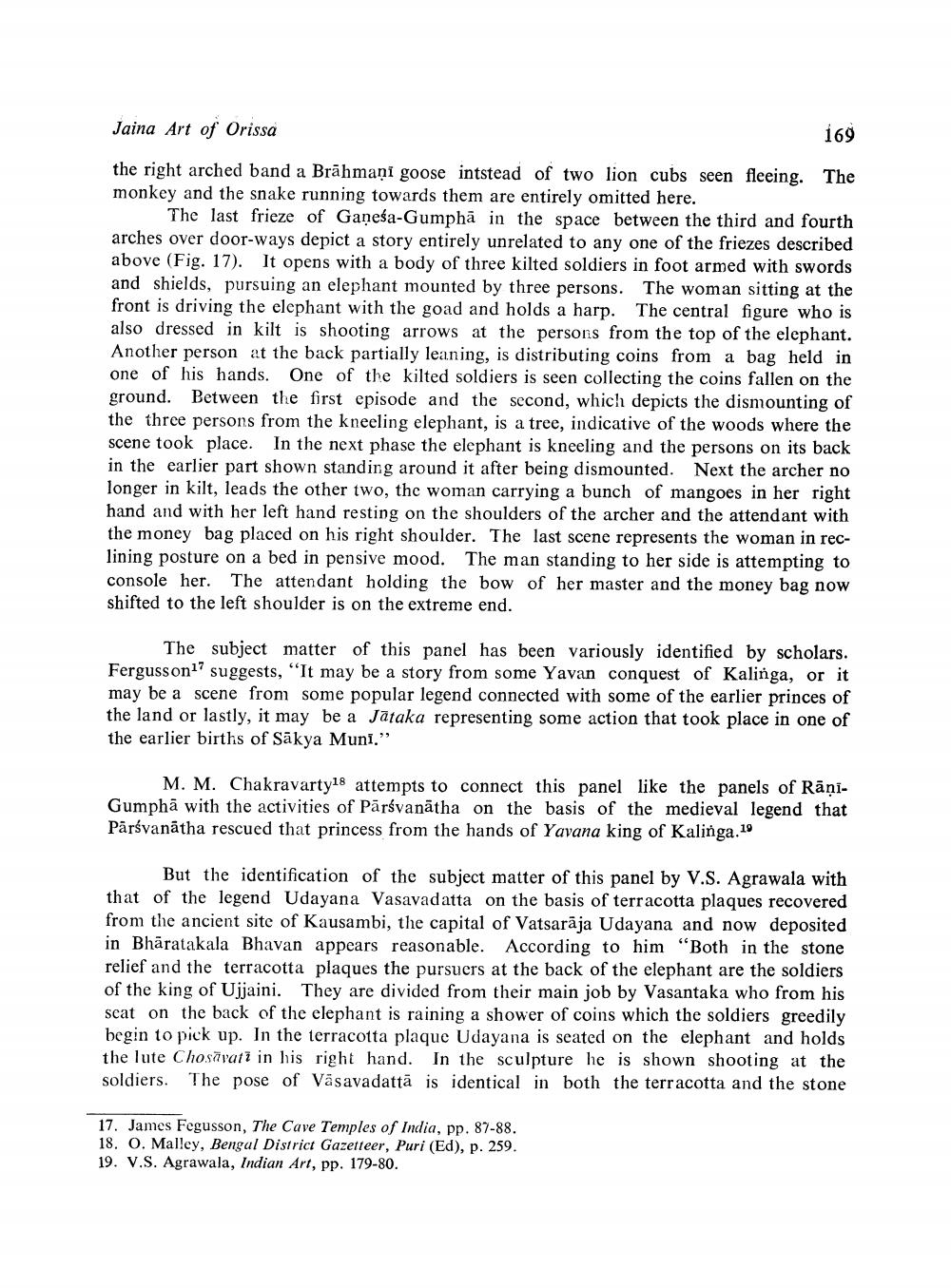________________
Jaina Art of Orissa
169
the right arched band a Brāhmaṇi goose intstead of two lion cubs seen fleeing. The monkey and the snake running towards them are entirely omitted here.
The last frieze of Gaṇeśa-Gumphâ in the space between the third and fourth arches over door-ways depict a story entirely unrelated to any one of the friezes described above (Fig. 17). It opens with a body of three kilted soldiers in foot armed with swords and shields, pursuing an elephant mounted by three persons. The woman sitting at the front is driving the elephant with the goad and holds a harp. The central figure who is also dressed in kilt is shooting arrows at the persons from the top of the elephant. Another person at the back partially leaning, is distributing coins from a bag held in one of his hands. One of the kilted soldiers is seen collecting the coins fallen on the ground. Between the first episode and the second, which depicts the dismounting of the three persons from the kneeling elephant, is a tree, indicative of the woods where the scene took place. In the next phase the elephant is kneeling and the persons on its back in the earlier part shown standing around it after being dismounted. Next the archer no longer in kilt, leads the other two, the woman carrying a bunch of mangoes in her right hand and with her left hand resting on the shoulders of the archer and the attendant with the money bag placed on his right shoulder. The last scene represents the woman in reclining posture on a bed in pensive mood. The man standing to her side is attempting to console her. The attendant holding the bow of her master and the money bag now shifted to the left shoulder is on the extreme end.
The subject matter of this panel has been variously identified by scholars. Fergusson1 suggests, "It may be a story from some Yavan conquest of Kalinga, or it may be a scene from some popular legend connected with some of the earlier princes of the land or lastly, it may be a Jataka representing some action that took place in one of the earlier births of Sakya Muni."
M. M. Chakravarty's attempts to connect this panel like the panels of RaniGumpha with the activities of Pärávanatha on the basis of the medieval legend that Pārsvanatha rescued that princess from the hands of Yavana king of Kalinga."
But the identification of the subject matter of this panel by V.S. Agrawala with that of the legend Udayana Vasavadatta on the basis of terracotta plaques recovered from the ancient site of Kausambi, the capital of Vatsaraja Udayana and now deposited in Bharatakala Bhavan appears reasonable. According to him "Both in the stone relief and the terracotta plaques the pursuers at the back of the elephant are the soldiers of the king of Ujjaini. They are divided from their main job by Vasantaka who from his scat on the back of the elephant is raining a shower of coins which the soldiers greedily begin to pick up. In the terracotta plaque Udayana is seated on the elephant and holds the lute Chosavati in his right hand. In the sculpture he is shown shooting at the soldiers. The pose of Vasavadatta is identical in both the terracotta and the stone
17. James Fegusson, The Cave Temples of India, pp. 87-88.
18. O. Malley, Bengal District Gazetteer, Puri (Ed), p. 259. 19. V.S. Agrawala, Indian Art, pp. 179-80.




